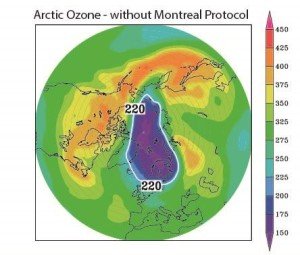The Montreal Protocol has prevented a supersized Antarctic ozone hole and a ‘full blown’ Arctic ozone hole, a new study has revealed.

Credit: Chipperfield et al., Nature Communications
Scientists have modelled what the ozone layer would have looked like if ozone-damaging chemicals, known as chloroflurocarbons (CFCs), had not been banned by the 1989 Montreal Protocol.
The research, published in Nature Communications this week, has predicted that the ozone hole over Antarctica would have been 40 per cent larger than it is today.
In addition, the study suggests that a fully formed ozone hole over the Arctic would have appeared by 2011.
This would have wide-reaching consequences including increased surface UV radiation, explains NIWA atmospheric scientist Dr Richard McKenzie, who worked on the study with UK researchers.
“There was never a corresponding ozone hole in the Arctic because wind patterns were different. However, this paper shows that if had not been for the Montreal Protocol there would have been an Arctic ozone hole occurring for the first time in 2011,” he says in a press release.
“That is serious because, unlike Antarctica, a lot of people live up there, and they would have been exposed to far higher levels of UV than normally experienced at that time of year,”
The model predicted that the UV radiation could have risen by 8-12 per cent in New Zealand and Australia, and by as much as 14 per cent in the UK and Northern Europe.
An increase in exposure to sun-burning UV would lead to a gain in the two most common forms of skin cancer according to the study.
The research has been covered widely in New Zealand and worldwide. Examples include:
TVNZ: Ozone hole would be 40% bigger if not for CFC ban
RadioNZ: The ozone hole: what could have happened
The New Zealand Herald: Ozone treaty reduced NZ cancer rates
3News: Ozone layer’s revival saves thousands from skin cancer – study
BBC News: How Arctic ozone hole was avoided by Montreal Protocol
The Sydney Morning Herald: Model shows what ozone layer would look like without Montreal Protocol